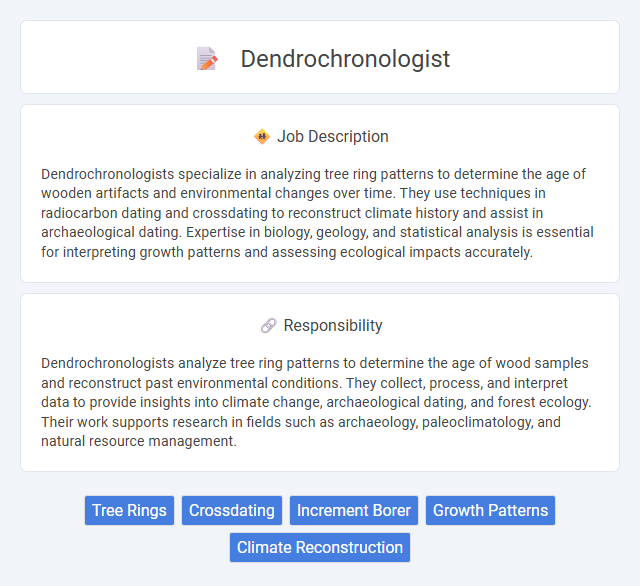
Dendrochronologists specialize in analyzing tree ring patterns to determine the age of wooden artifacts and environmental changes over time. They use techniques in radiocarbon dating and crossdating to reconstruct climate history and assist in archaeological dating. Expertise in biology, geology, and statistical analysis is essential for interpreting growth patterns and assessing ecological impacts accurately.
Individuals with a strong attention to detail and a passion for environmental science are likely to find dendrochronology appealing, as the job requires meticulous analysis of tree rings to study climate and ecological changes. People comfortable with outdoor fieldwork and laboratory research may be well-suited, while those who prefer less physically demanding or repetitive tasks might find it challenging. Those with patience and an interest in historical and environmental data interpretation probably have a higher probability of thriving in this role.
Qualification
Dendrochronologists typically require a strong background in archaeology, geology, or environmental science, often holding a bachelor's or master's degree in these fields. Expertise in tree-ring analysis techniques, laboratory skills, and proficiency with dating software are essential qualifications. Experience in field sampling, data interpretation, and a keen eye for detail enhance their ability to accurately date events and environmental changes.
Responsibility
Dendrochronologists analyze tree ring patterns to determine the age of wood samples and reconstruct past environmental conditions. They collect, process, and interpret data to provide insights into climate change, archaeological dating, and forest ecology. Their work supports research in fields such as archaeology, paleoclimatology, and natural resource management.
Benefit
Dendrochronologists likely benefit from the ability to precisely date historical events and environmental changes by analyzing tree ring patterns. This expertise might contribute significantly to fields like archaeology, climate science, and conservation, potentially leading to impactful research and policy development. Opportunities for collaboration with multidisciplinary teams could enhance knowledge and career growth prospects within this specialized field.
Challenge
Dendrochronologists likely face challenges in accurately dating wood samples due to environmental variables affecting tree ring growth patterns. The complexity of correlating ring patterns across different regions may require advanced analytical skills and patience. Limited access to well-preserved samples could also pose significant obstacles in conducting thorough research.
Career Advancement
Dendrochronologists specializing in tree-ring analysis often advance their careers by gaining expertise in specialized techniques such as radiocarbon dating and climate reconstruction. Progression typically involves transitioning from field data collection to roles in research institutions, academia, or consulting firms, where leadership in large-scale environmental projects is common. Mastery of statistical analysis software and interdisciplinary collaboration enhances opportunities for senior positions in forestry management, archaeology, and climate science sectors.
Key Terms
Tree Rings
Dendrochronologists specialize in studying tree rings to analyze past climate conditions, date archaeological sites, and monitor environmental changes. Each tree ring provides precise annual data, enabling reconstruction of historical weather patterns and ecological shifts over centuries. Mastery in crossdating tree ring samples allows dendrochronologists to build accurate chronological timelines essential for research in climatology and forestry.
Crossdating
Dendrochronologists specialize in the scientific method of crossdating, which involves comparing tree-ring patterns from different trees to determine precise calendar years of growth. This technique enables accurate dating of wooden artifacts, historical structures, and environmental events by aligning overlapping ring sequences. Expertise in crossdating is essential for reconstructing past climates, archaeological studies, and validating radiocarbon dating results.
Increment Borer
Dendrochronologists use increment borers to extract core samples from trees, enabling precise analysis of annual growth rings for dating and climate studies. The tool allows measurement of ring width, density, and isotopic composition, providing vital data for ecological and archaeological research. Mastery of increment borer technique ensures minimally invasive sampling and accurate record of tree age and environmental conditions.
Growth Patterns
Dendrochronologists analyze tree ring growth patterns to date events and environmental changes accurately. These growth patterns reveal critical information about climate variations, ecological disturbances, and historical timelines. Expertise in interpreting ring width, density, and isotopic composition enables precise reconstruction of past environmental conditions.
Climate Reconstruction
Dendrochronologists analyze tree ring patterns to reconstruct historical climate conditions with high precision, providing valuable data on past temperature, precipitation, and atmospheric changes. Their expertise enables the correlation of growth rings with environmental variables, aiding in the understanding of long-term climate variability and extreme weather events. This method contributes to refining climate models and predicting future climatic trends based on empirical evidence.
 kuljobs.com
kuljobs.com